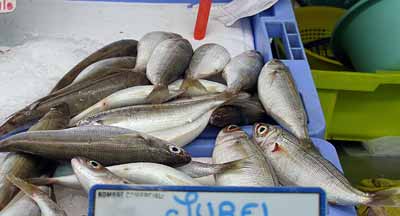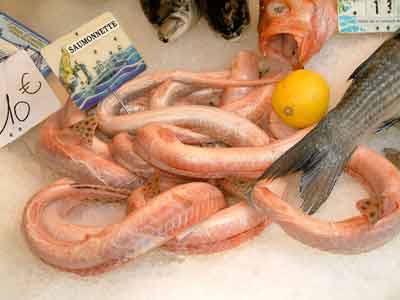Wels or sheetfish. A type of catfish that can grow up to 5 m (16 ft) in the wild and is Europe's largest freshwater. It is found in the Rhine River in Germany eastwards to the Black and Caspian Seas. The elongated wels body consists of a powerful forebody and a laterally greatly compressed tail shaft; the prominent anal fin merges with the caudal fin. This fish, with its calm undulating tail movements normally has its long pair of upper jaw barbels pointing straight forward, while the four smaller barbels of the lower lip hang down. The dorsal fin, consisting of just four rays, seems small for such a powerful animal. In the wild they have been known to eat ducks where they rush up behind them at night, sucking them into their mouths with a vortex motion. In their native habitat they feed on other fishes mainly eels, burbot, tench and roach, but it also takes water voles.
Wels or sheetfish. A type of catfish that can grow up to 5 m (16 ft) in the wild and is Europe's largest freshwater. It is found in the Rhine River in Germany eastwards to the Black and Caspian Seas. The elongated wels body consists of a powerful forebody and a laterally greatly compressed tail shaft; the prominent anal fin merges with the caudal fin. This fish, with its calm undulating tail movements normally has its long pair of upper jaw barbels pointing straight forward, while the four smaller barbels of the lower lip hang down. The dorsal fin, consisting of just four rays, seems small for such a powerful animal. In the wild they have been known to eat ducks where they rush up behind them at night, sucking them into their mouths with a vortex motion. In their native habitat they feed on other fishes mainly eels, burbot, tench and roach, but it also takes water voles.

Boops or bogue, an inferior variety of sea bream. These are brightly coloured, silvery yellow, spindle-shaped fish with large eyes abundant in the Mediterranean about 20-30 cm (8-12 inches) long. They are usually used in fish soups or are served grilled.
Argentine. A small marine fish with silvery scales similar to a sardine or a smelt. It is usually grilled or fried.
"White fish." Sneep. A gregarious relation of the carp. It is found in the upper reaches of rivers, where it likes fast-moving water so may be found around piers or bridges of where currents speed around obstructions in the water. Its mouth is designed for scraping algal growths from stones. The flesh is tasty but has many bones which discourages people from eating it.
Triggerfish. A brightly coloured Mediterranean fish, more common in the southern Mediterranean than than the northern. It must be skinned before cooking as the skin is very tough.

Huss. This species of dogfish has a grey-brown skin with quite pronounced dark spots. Because of its relative similarity to a shark the coarse skin is usually removed by fishmongers. These fish grow to about 80 cm (32 inches) in length. The flesh is white or pinkish with a firm texture and good flavour. It is boneless. It is also commonly known as the spotted dogfish or nursehound or, in some places, as rock salmon or rock eel. Spurdog, smoothound and tope are all sold as huss. It is an excellent addition to soups because of its texture. It feeds on shellfish which flavours its own firm, white flesh.